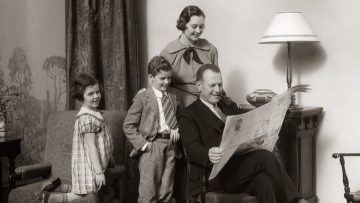Wilcox and Boyd in The Atlantic:
 The nuclear family is disintegrating—or so Americans might conclude from what they watch and read. The quintessential nuclear family consists of a married couple raising their children. But from Oscar-winning Marriage Story’s gut-wrenching portrayal of divorce or the Harvard sociologist Christina Cross’s New York Times op-ed in December, “The Myth of the Two-Parent Home,” discounting the importance of marriage for kids, one might draw the conclusion that marriage is more endangered than ever—and that this might not be such a bad thing. Meanwhile, the writer David Brooks recently described the post–World War II American concept of family as a historical aberration—a departure from a much older tradition in which parents, grandparents, siblings, and cousins all look out for the well-being of children. In an article in The Atlantic bearing the headline “The Nuclear Family Was a Mistake,” Brooks argued that the “nuclear family has been crumbling in slow motion for decades.” He sees extended families and what he calls “forged families”—single parents, single adults, and others coming together to support one another and children—as filling the vacuum created by the breakdown of the nuclear family.
The nuclear family is disintegrating—or so Americans might conclude from what they watch and read. The quintessential nuclear family consists of a married couple raising their children. But from Oscar-winning Marriage Story’s gut-wrenching portrayal of divorce or the Harvard sociologist Christina Cross’s New York Times op-ed in December, “The Myth of the Two-Parent Home,” discounting the importance of marriage for kids, one might draw the conclusion that marriage is more endangered than ever—and that this might not be such a bad thing. Meanwhile, the writer David Brooks recently described the post–World War II American concept of family as a historical aberration—a departure from a much older tradition in which parents, grandparents, siblings, and cousins all look out for the well-being of children. In an article in The Atlantic bearing the headline “The Nuclear Family Was a Mistake,” Brooks argued that the “nuclear family has been crumbling in slow motion for decades.” He sees extended families and what he calls “forged families”—single parents, single adults, and others coming together to support one another and children—as filling the vacuum created by the breakdown of the nuclear family.
Yet the search for alternate forms of family has two major flaws. First, there’s evidence indicating that the nuclear family is, in fact, recovering. Second, a nuclear family headed by two loving married parents remains the most stable and safest environment for raising children. There are, of course, still reasons for legitimate concern about the state of the American family. Marriage today is less likely to anchor family life in many poor and working-class communities. While a majority of college-educated men and women between 18 and 55 are married, that’s no longer true for the poor (only 26 percent are married) and the working class (39 percent). What’s more, children from these families are markedly less likely to live under the same roof as their biological parents than their peers from better-off backgrounds are.
But there is also ample good news—especially for kids.
Today, the divorce rate is down, having fallen by more than 30 percent since peaking around 1980, in the wake of the divorce revolution. And, since the Great Recession, out-of-wedlock births are now dipping as well.
More here.
